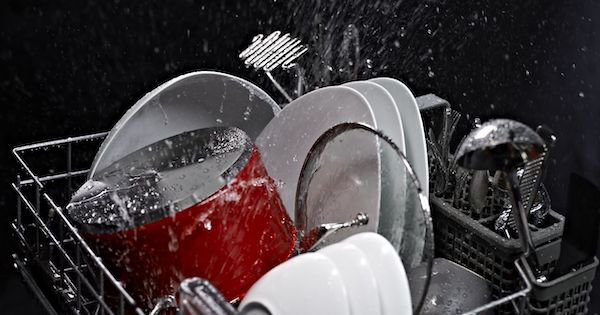
There's no doubt about it: dishwashers save us a ton of time. We no longer have to spend up to an hour or more processing the day's dishes with a sink full of soapy water and a bunch of towels on hand. Washing your dishes in a dishwasher uses less water than hand washing and is also a lot more sanitary: today's dishwashers heat the water to 140°F or higher to blast away germs.
However, if you're dealing with a dishwasher not drying properly, it can be tempting to revert to the old ways! Before you throw in the towel or call a repair service, we have seven quick fixes you can try to improve your dishwasher's drying performance. If it's time to buy a new model, check out our dishwasher buying guide!
If you have a new dishwasher that's not drying well, we have a series of tips to help you out. If your dishwasher recently stopped drying dishes, we outline some possible causes.
Table of Contents
New Dishwasher Not Drying Dishes
Newer dishwashers have moved away from the old heated dry method in order to conserve energy. The upside of this is that new methods like condensation and fan-assisted drying are less likely to melt plastics! It's also a factor in why today's dishwashers cost just $35 per year to run on average, compared to about $160 per year in the 1980s! The downside is that your dishes may not be as thoroughly dry as they used to be.
What's normal with these new dishwashers?
-
Some moisture typically lingers on the top rack since that's where we usually put plastics. Plastics are hard to dry. You are likely to find moisture in the rims of plastic containers and in the curved bottoms of coffee mugs. The more oddly shaped the item and the more crevices it has, the harder it is to dry. Plates and silverware should be relatively dry.
-
Even dishwashers with a heated dry option (which uses a heating coil hidden in the base of the tub) won't necessarily dry better - it varies a lot between different models. Bosch recently came out with a form of heated dry called CrystalDry that uses a mineral that releases heat when exposed to moisture, so you can have much dryer dishes without impacting energy usage. Click here to explore CrystalDry dishwashers.
-
Condensation drying is becoming more common and is found on most stainless steel tub dishwashers. Basically, the dishwasher pulls water off of the dishes to condense on the sides of the tub.
-
Fan-assisted drying is offered by a lot of American brands (such as KitchenAid, Frigidaire, etc), and usually works in tandem with condensation drying methods. Increasing ventilation and air movement helps pull moisture from your dishes.
- Longer cycle times are likely as well, especially if you choose hot rinses, heavy duty/sanitize cycles, or extended dry options.
Sometimes the reason for a dishwasher not drying well is due to a simple issue that you can fix on your own. Although we offer repair services for the appliances we sell, we know that sometimes people want to do their own troubleshooting steps. So let's dig into a few quick fixes for a dishwasher not drying!

1. Unload the Lower Rack First
We often put our plastic containers and cups on the top rack. These items are more likely to collect pools of water that can spill on the items on the lower rack as you unload them. Plastics are harder to dry than ceramics, glass, and metals, so your dishwasher not drying problem may be due to a lot of plastics rather than due to a flaw in the dishwasher itself.
2. Use a Rinse Aid
"Rinse Aid" may sound like another product gimmick, but they can actually be pretty useful: they help water bead up and roll off of the items in your dishwasher during the final rinse, instead of the water "sticking" to your dishes. A Rinse Aid can also be helpful for issues like water spots on glassware and mineral scale due to hard water. If you have soft water, you'll need less.
You might see rinse aids promoted for reducing water spots on glassware, but they help with drying as well. There are a variety of brands available, from popular dishwasher detergent brand Cascade to earth-friendly Seventh Generation. Newer dishwashers often have compartments for rinse aids that you can fill up for multiple uses, and these dishwashers can even alert you when you're running low. Many manufacturers recommend using these products, and they may be worth considering if you're going crazy from your dishwasher not drying!
3. Choose a Cycle with a High Heat Final Rinse
Especially if you have a condensation dry dishwasher, one of the best ways to get water to condense off of your dishes and onto the dishwasher tub is to make the final rinse a hot one. Again, note that plastics resist drying because they cool down more quickly than other materials.
Look for heated final rinse options like SaniRinse, or heavy-duty cycles like Pots & Pans. You can refer to your dishwasher manual to choose the right cycle or option, since different manufacturers use different names for their cycles. Finishing the cycle with a hot final rinse will help make the condensation dry method more effective, although keep in mind that this can make your dishwasher take longer since its internal heater needs to raise the temperature of the water.
4. Check Your Hot Water Heater Settings
If your dishwasher can't get up to those hot water temperatures it needs to make the condensation dry effective, the result may be a dishwasher not drying. For the best results, the water entering your dishwasher needs to be between 120-150°F. This is especially important if your dishwasher model is one that does not automatically heat the water to a certain temperature (most newer mid-range and up dishwashers will heat water to 140°F before starting).
You should also check that there is hot water available when you run the dishwasher. For example, if you like to run the dishwasher in the morning after everyone has showered, or in the evening when your hot water heater is set to turn off for the night, your dishwasher may not have hot enough water to do a proper wash and dry.
Making sure your hot water heater settings are correct can also help reduce cycle times, since your dishwasher will need to use fewer fill cycles to bring the water up to temperature. Some higher-end dishwashers will even pause the cycle to increase the water temperature. So if the water going into your dishwasher is at that 120°F sweet spot, you'll have cleaner, dryer dishes more quickly!
5. Try the "Flash Dry" Method
The emergency situation: you've been struggling with your dishwasher not drying, but you're having company over and want your nice plates freshly cleaned and dried. The "flash dry" method is easy if you get the timing right: just open the dishwasher door after the final rinse and drain. The cooler air outside will pull the hot, moist air out of your dishwasher to leave your dishes. This can take up to ten minutes depending on what items are in the dishwasher, but it's a lot better than hand-drying with towels!
Set a timer on your phone or oven if you want an extra reminder to flash dry your dishes after the final rinse and drain!
Fun fact: some Samsung dishwashers basically have this feature built-in, automatically popping the door open when the cycle is finished to help speed up the drying process. As of 2019, Bosch is incorporating a similar features into their dishwashers!
6. Avoid Overloading Racks & Free-Flying Plastics
Leave enough space between the plates and other items in your dishwasher for air and water to circulate freely so that the drying process will work as intended. Place cups, small bowls, and dishwasher-safe plastics on the top rack. Some dishwashers come with clips to secure lightweight plastic items - loading these items securely will help prevent them from flipping over and then filling up with water during the cycle.
Plates, silverware, and larger items generally go in the lower rack. Depending on where your dishwasher sprays water from, you'll want to make sure that any large or oddly shaped items are not blocking the spray arms from being able to move freely and reach all areas of the dishwasher.
Try not to overlap items, such as leaning plastic containers against each other, as this can impede proper cleaning and drying.
7. Stop Prewashing Your Dishes!
If you do a thorough prewash or rinse before loading your dishes, and you have a newer dishwasher with a soil sensor, you might be inadvertently making its job harder! It can mess with the cycle and impact cleaning performance in addition to drying performance. Plus, your dishwasher detergent needs debris to grab onto and really clean.
Scrape your dishes clean, but otherwise don't try to rinse or sponge away every hint of residue.
8. Check for a Manually-Activated Drying Option
Although heated dry is becoming less common since it requires so much electricity, some dishwashers still come with this option. However, you may have to select it or turn it on manually! Check your dishwasher manual to see if this option is offered. Different brands and models will have different heated dry buttons and options. Some cycles will include heated dry, while others will not. For example, in Whirlpool dishwashers with heated dry, you'll need to manually select the Heated Dry option for the Quick Wash or 1-Hour Wash cycles.
Some dishwashers also offer dry-boosting options even if they don't have a heat dry option that may improve drying performance (although the cycle may end up taking longer).
Note that not all dishwashers offer a heated dry option anymore, so that's definitely a feature to ask about if you're shopping for a new dishwasher. An experienced salesperson can help you weigh the pros and cons of different drying methods and help you avoid the dishwasher not drying issue entirely!
My Dishwasher Used to Dry My Dishes... Now It Doesn't
This typically indicates a mechanical issue, of course. If your dishwasher has had a recent decrease in drying performance, there are a few potential causes for this.
-
A blocked or malfunctioning vent or vent fan motor. Some front control dishwashers, in particular cheaper models, may have a visible vent on the exterior that is supposed to open after the wash cycle to let out steam. Usually a fan is involved to help drive this moisture out of the tub.
-
On top control dishwashers, this vent system may be concealed within the door. If you don't see visible steam during the drying cycle, that usually means the moisture is condensed out of the air and drains back into the base of the tub.
-
-
If you use Rinse Aid, and you've noticed a decrease in drying performance, there may be an issue with the rinse aid dispenser - specifically, the cap. If the cap is warped or otherwise damaged, it may not be releasing rinse aid properly during the cycle. There could also be a larger issue with the rinse aid dispenser itself.
-
If you have a heated dry dishwasher, the heating element is an obvious potential issue. Additionally, a malfunctioning high limit thermostat is supposed to keep your dishwasher from getting too hot, but a malfunctioning thermostat can turn off the heat too soon and result in wet dishes.
That sums up our tips for dealing with a dishwasher not drying. If you're still having trouble with your dishwasher, we recommend contacting a local repair service to take a look. Sometimes the cause is simple, and sometimes it requires a professional to diagnose and fix it! And if you're looking for a new dishwasher, check out our reviews of the best dishwashers of the year!
Did any of these tips work for you? Do you have more recommendations for people struggling with this issue? Leave us a comment below - We'd love to hear from you!
Editor's Note: This blog was originally written in November of 2018 and has been completely revamped and updated for accuracy as of the publication date noted above.





